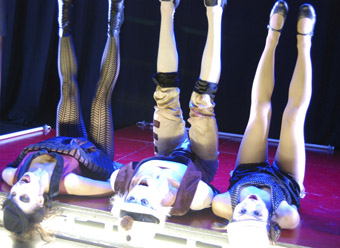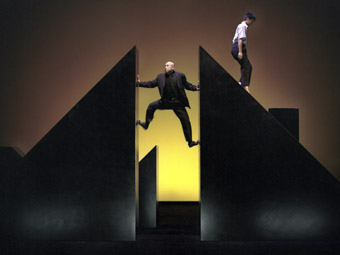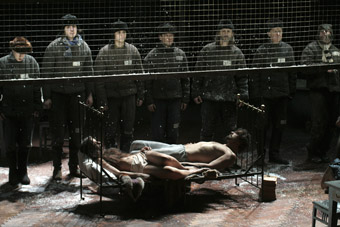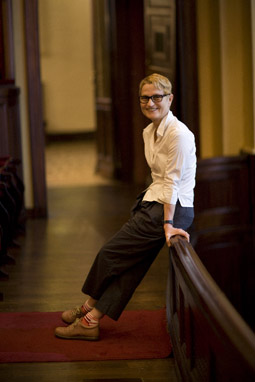celebration against the odds
maggi phillips: dance & theatre in the 2010 perth festival

Dancing on Your Grave, a Cholmondeley and Featherstonehaugh’s production
images courtesy PIAF
Dancing on Your Grave, a Cholmondeley and Featherstonehaugh’s production
THE 2010 PERTH INTERNATIONAL ARTS FESTIVAL MAKES NO CLAIM TO THEMATIC COHERENCE AND YET THE FOLLOWING SAMPLING OF PERFORMANCES REVEALS AN ONGOING ARTISTIC CONCERN WITH THE LIMITS OF IDENTITY, WHETHER IN POLITICAL CONTEXTS OR TESTED AGAINST ANIMATE/INANIMATE DETERMINANTS. DEMONSTRATIONS OF SINGULAR IDENTITY CAN SPAWN TENSIONS, OFTEN WITH COMPLEX AND CHILLING REPERCUSSIONS OR, ALTERNATIVELY, CAN FORM UNITIES WHERE COMPLEMENTARY OPPOSITIONS CREATE THE EVENT’S SINGULARITY.
A handful of dead souls who rev up life in a pub of zero intoxication and intone freedom from pancreatic tracts might turn tensions between life and death on their head. Unfortunately, the framing gag of a spectral music-hall with its tight staging, small cast and banjo-strummed ballads sits at odds with the wide-flung technicolour skyline of Perth on a balmy night. How could the imported UK mortuary wit, however clever in its intimacy and comedic lyrics, compete with the external spectacle of nature provided free by the city? In director-choreographer Lea Anderson’s Dancing on Your Grave, the Cholmondeleys (an all-female contemporary dance company) and the Featherstonehaughs (its male equivalent) were in short supply which only emphasised the show’s reliance on Burch and Blake’s original songs delivered live at Beck’s Music Box. Lusciously opening out onto The Esplanade, Beck’s Box lacked the necessary ambience of enclosure, crowds and unruliness to realise the production’s odd Dickensian humour.

Les Sept Planches de la Ruse (Seven Boards of Skill)
image courtesy PIAF
Les Sept Planches de la Ruse (Seven Boards of Skill)
Les Sept Planches de la Ruse (Seven Boards of Skill), a French Chinese production, conceived by Aurélien Bory with performers from the Dalian Beijing Opera, generated an inverse effect. The Regal, an old, ungainly theatre commonly used for brash commercial productions was transformed by dreamlike kinetic art propelled by the gliding force of mass and numbers. Huge tangram shapes slid, balanced and cohered under the manipulations and escalations of their human partners. The glancing run of these Chinese acrobats wheeled around the space to upturn triangular mountains and, in the next breath, curled exquisite song and sound through sculptural corridors. Meditative and poetic, the union of landscape and human stirred interpretation. There was a gecko-like trail of humans scaling the block-face in coordinated angles, like Escher’s lizards endlessly advancing towards metamorphosis together with unframed moments of suspension, wherein a single human teeter-boarded a triangular block on its apex, hovering before the configuration tilts and slides into a new wedged form. Awareness of the difficulty for both human and the blocked shape evaporated with the skilful resolution of topological movement and the slightness of its human counterparts in a continuum of unity.

Life and Fate, Maly Drama Theatre, St Petersburg
image courtesy PIAF
Life and Fate, Maly Drama Theatre, St Petersburg
In contrast, Life and Fate describes the will of nuclear scientist, Shtrum, to survive with the credibility of his ideas intact in spite of the destruction of society wielding its incomprehensible power around him. The play is based on the novel by Vasily Grossman, adapted and staged by Lev Dodin and the Maly Drama Theatre. Leaving aside the difficulties of subtitles in an understandably wordy text and the stereotypical overpopulation of sweeping Russian novels, Life and Fate extricated a bitter blend of condemnation and compassion for the acrobatic propensity of the human conscience within the debris of its set. The horror of entrapment in hydra-armed fear is particular to a revolutionary culture brought to its knees by failed aspirations and unvanquished enemies, within and beyond. An Australian audience probably trip-wires over circumstances in everyday Soviet life where Holocaust and Gulag retribution threaten in equal measure and yet this production, given the stamina of the audience to hold out for its three-plus hours of plot unravelling, does register familiar stings of small lies and self-deception.
The Maly actors skilfully inhabit a stage conflated in time and location, which is at once pre- and post-Stalinist apartment crossed by the symbolic wires of encampment and annihilation. Both life and vodka are cheap and drained in a moment. The significance of this state becomes increasingly clear in the second half which culminates in the barbed belittlement of a band of denuded humanity literally playing the final chords of their condemned lives. It is an extraordinary moment wherein music and bare flesh fuse and are extinguished. The echo of that poignancy-crushed-in-violence emanates through the mother’s final letter just before she too leaves life to her son and his conscience.

Robyn Orlin
photo Olivier Pascaud
Robyn Orlin
Meeting Robyn Orlin, a South African choreographer working between Paris, Berlin and Johannesburg, represents another step in STRUT’s workshop series aimed at informing locals about international trends and extending vistas about what dance might be. In amongst the polished performances of the Perth Festival, this showing at the Kings Street Arts Centre was unashamedly chaos-in-progress. Selected guests entered unawares into a mayhem of fancy-dress and scattered paraphernalia, plied by questions and demands for dollars. The obtuse play seemed cranked towards ordering, via a projected Skype, a sharing loaves-and-fishes-style of one ‘veg’ and one ‘non-veg’ wrap. Division appeared to be an Orlin strategy for creating material as well as a thematic probe into discrimination by replacing race with arbitrary characteristics like vegetarianism. It was a flippant glimpse into what might materialise in the future as a complement to the Russian Life and Fate.
Good Morning, Mr Gershwin presented by Compagnie Montalvo-Hervieu from France, rapped nostalgia into explosive exuberance and rhythmical virtuosity. “I got rhythm” speed-splintered through every conceivable nook and cranny of the body, bouncing across dance techniques and spatial configurations like nerve-ends in frenzied delight. Fusion was further promoted in the cast mix of African, Arabic, Asian and European performers and the final Porgy and Bess sequence. While possibly paying too much credence to Gershwin’s political tolerance, Porgy provoked powerful performances from the women whose anguish shuddered bodily, banishing all vestiges of feminine frailty. In overview, playfulness flipped with desire and protest in the same way that Gershwin may have skittered across the piano’s black and white keys. The message resoundingly unified divisive fragments into melodies that are difficult to resist.
Death images struck down by mere humans who refuse to doubt the immortality of song linger after the festival and the orchestrated harmonies of its performances. Perhaps that is what any festival should achieve, an impossible celebration against the odds.
2010 Perth International Arts Festival: The Cholmondeleys and The Featherstonehaughs, Dancing on Your Grave, director, choreographer Lea Anderson, Beck’s Music Box, Feb 23, 24; Les Sept Planches de la Ruse, conception, stage designer, director Aurélien Bory, producers Compagnie 111m Scènes de la Terre, performers Dalian Beijing Opera, Regal Theatre, Feb 5-March 1; Maly Drama Theatre, St Petersburg, Life and Fate, based on the novel by Vasily Grossman, adaptation, direction Lev Dodin, His Majesty’s Theatre, Feb 17–23; Strut, Meet Robyn Orlin, facilitator Bianca Martin, Kings St Arts Centre, Feb 26; Compagnie Montalvo-Hervieu, Good Morning, Mr Gershwin, choreography José Montalvom Dominique Hervieu, music George Gershwin, His Majesty’s Theatre, Feb 26-28
For more on the Perth International Arts Festival see the review of Victoria Vesna and James Gimzewski’s Nanomandala on page 24.
RealTime issue #96 April-May 2010 pg. 12






